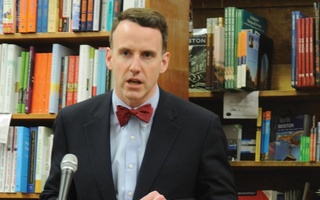Student criticism of the University’s communication with the Harvard community after last Monday’s bombings at the Boston Marathon and the subsequent manhunt for the bombing suspects has drawn increased attention to the University’s process of alerting students during emergencies.
In times of crisis, universities must make rapid, “case-by-case” decisions regarding communication with students, campus security experts told The Crimson. Effective communication requires a balance between timely notification and reporting accurate information—a challenge magnified by the growth of social media.
“[University officials] want to encourage caution but not paranoia,” said Robin H. Gray, executive editor of Campus Safety Magazine. “They don’t want to cause too much commotion.”
Nonetheless, students last Monday criticized what they considered delayed and insufficient communication from the administration on the bombings at the Marathon and complained that the more than two-hour gap between the first reports of the incident and the first University-wide email acknowledging the bombings was too long.
Late Thursday night and into early Friday morning, students also expressed disappointment in the timing of the University’s communication with undergraduates following a fatal shooting on MIT’s campus, though members of the Undergraduate Council noted improvement on Friday. In total, the University sent out 14 alerts on Thursday and Friday.
Campus security experts cited the Clery Act, a federal law that requires universities to design an emergency response system and issue timely, accurate, and useful warnings of campus threats, as the primary statute on campus security. Under the Act, campuses are required to publish an Annual Security Report that contains crime statistics and details about the institution’s alert system.
Harvard’s 2012-2013 ASR states that during emergencies, members of the University’s Crisis Management Team will coordinate with HUPD officers and officials from Harvard’s Public Affairs and Communications Office to decide on the content and audience of alerts sent through the University’s MessageMe system as well as through phone, email, web, and Twitter.
This moment, when University officials determine the timing and content of emergency notices, has drawn scrutiny at Harvard.
“What we know from managing critical incidents anywhere is that during the crisis phases, good, accurate information is nearly impossible,” said Gary Margolis, a former police chief at the University of Vermont and State Agricultural College and managing partner at campus security firm Margolis, Healy & Associates. “The challenge is that the expectation for the speed of information is out of sync with the accuracy of the information.”
This tension between speed and accuracy, Margolis said, is exacerbated by social media, which enables rapid exchange of information but lacks checks for accuracy.
Gray said she agreed, calling social media “a mixed blessing.” In a list of best practices for campus security, she called for University officials to use social media—increasingly a favored mode of communication amongst students—as a tool for addressing rumors rather than spreading them.
Gray also advised against bureaucratic chains of command that could slow down the process of issuing an emergency alert and recommended that universities maximize the spread of information by employing many different types of notification. She added that universities are responsible for maintaining strong relationships with local law enforcement officials in order to ensure proper information in times of crisis.
In addition to the challenge of securing up-to-date information, universities must be discreet when determining what to disclose about a fluid emergency situation, wrote Alison Kiss, executive director of the Clery Center for Security on Campus, in an email to The Crimson. According to Kiss, the Clery Act does not specify a timeframe for issuing alerts and gives campuses the right to withhold information that may compromise a criminal investigation.
Neither Gray nor Margolis commented directly on the way that Harvard handled communications about the bombings and lockdown last week, though on Friday afternoon, Gray said that the University seemed to be doing “what they should be doing.”
Peter F. Lake ’81, a professor at Stetson University College of Law who specializes in higher education law, said experiencing an emergency can help institutions like Harvard better navigate the complexities of communication during a crisis.
Read more in University News
University Closes With Marathon Bombing Suspect Still At-LargeRecommended Articles
-
Lost in TranslationIf measures are implemented to ensure all TFs have a thorough understanding of how to teach American students before entering the classroom, there will be more learned and less lost in translation.
-
 University Library Director Delves Into French Poetry
University Library Director Delves Into French Poetry -
 Glaeser Presents New Book on Cities
Glaeser Presents New Book on Cities -
Let’s TalkThe Undergraduate Council, one visible channel for affecting change, is perpetually under fire for alleged irrelevance and inability to meaningfully improve the Harvard student’s experience. In light of the stagnant relationship between students and the administration, the UC, led by President Senan Ebrahim, have proposed the Harvard University Forum for Change.
-
Technology and DecisionsRead Receipts reflect society’s movement away from traditional methods of long-distance communication and toward a more realistic model of in-person communication.
-
Students Criticize University Response to Marathon Explosions, Cambridge Bomb ThreatsIn the wake of two bomb explosions that killed three people and injured more than 130 others, Harvard students criticized what they described as the University’s slow communication with undergraduates.













